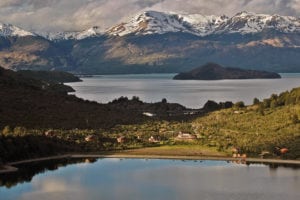Pristine landscapes, rushing rivers, and lush forests typify our travel through Chile on the Journey to Ushuaia tour. For a country that’s long and narrow, it’s jam-packed with diversity, amazing views, and heart-felt welcomes!
15 Fun Facts (plus a bonus) About Chile

- The Republic of Chile occupies a long narrow strip of land between the Andes and the Pacific Ocean. Peru borders the north; Bolivia the northeast; Argentina the east; the Drake Passage the south. Chilean territory includes numerous Pacific islands, including Easter Island and 1,250,000 km2/480,000 sq mi of Antarctica. Cape Horn, at its southern tip is known for high winds and treacherous waves.
- Chile is one of the longest countries in the world with a coastline of 6,500 km/4,000 miles. Its width of 200 km/125 miles makes it the world’s narrowest country. The Andes cover approximately eighty percent of the country, leaving less than four percent available for arable land.
- Geographical isolation has limited the immigration of wildlife so only a few of the distinctive South American animals are found here. They include the puma (cougar), the llama-like guanaco and the fox-like chilla. Several types of marsupials and small deer dwell in the southern forest region.
- Four species of penguins live in several areas of southern Chile. Humboldt Penguins also live on the north coast.
- Chile’s old! The world’s oldest known mummies, dating back to around 5050 BC, were discovered in the Camarones Valley. Stone tool evidence indicates a human presence as long as 18,500 years ago.
- About eighty-five percent of Chile’s 18.05 million (2017) residents live in urban areas in the central area, with forty percent living in Greater Santiago.
- Chile hosts at least ten major climatic subtypes, divided into three general zones: the northern desert, central Mediterranean, and the southern humid subtropical, rich in forests and lakes. An oceanic climate in the east and south includes alpine tundra and glaciers.
- The swimming pool at the San Alfonso del Mar Resort in Algarrobo, central Chile, is the largest in the world—1,013 metres/3,324’ long with an area of eight hectares/twenty acres. Most of the best-known beach resorts are in this area as well.
- The Atacama Desert is the driest place on earth and probably the oldest desert. Some parts of the region have never received a drop of rain.
- Great mineral wealth of the Atacama Desert makes Chile the world’s leading copper producer and source of most of the world’s lithium.
- Wine plays a significant economic and cultural role. More than 1,200 kilometres/800 miles of viticulture valleys in fourteen different areas produce more than ten million hectoliters of wine annually, making Chile the world’s fifth largest exporter and the ninth largest producer of wine. None of the vines, however, are indigenous to the region. Spanish colonizers first planted them in 1554.
- Aptly situated within the Pacific Ring of Fire, Chile counts over 1,300 volcanoes, a number of which are still active.
- Chile’s Villa Las Estrellas is one of the only two permanent civilian bases on Antarctica.
- Inhabitants refer to their country as the pais del poetas, or the country of poets. Well-known and beloved Chileans Gabriela Mistral and Pablo Neruda both won the Nobel Prize in Literature.
- The country is home to six UNESCO world heritage sites with an additional seventeen (2014) placed on the list for inclusion on the World Heritage Sites. Most of these are cultural, providing an insight into the majestic landscape’s human story.
Bonus fact: While on his world tour, Rene camped by the lake in the little town of Puerto Rio Tranquilo in southern Chile for two weeks, waiting for parts to show up for his broken motorcycle. Read about it in The University of Gravel Roads.

